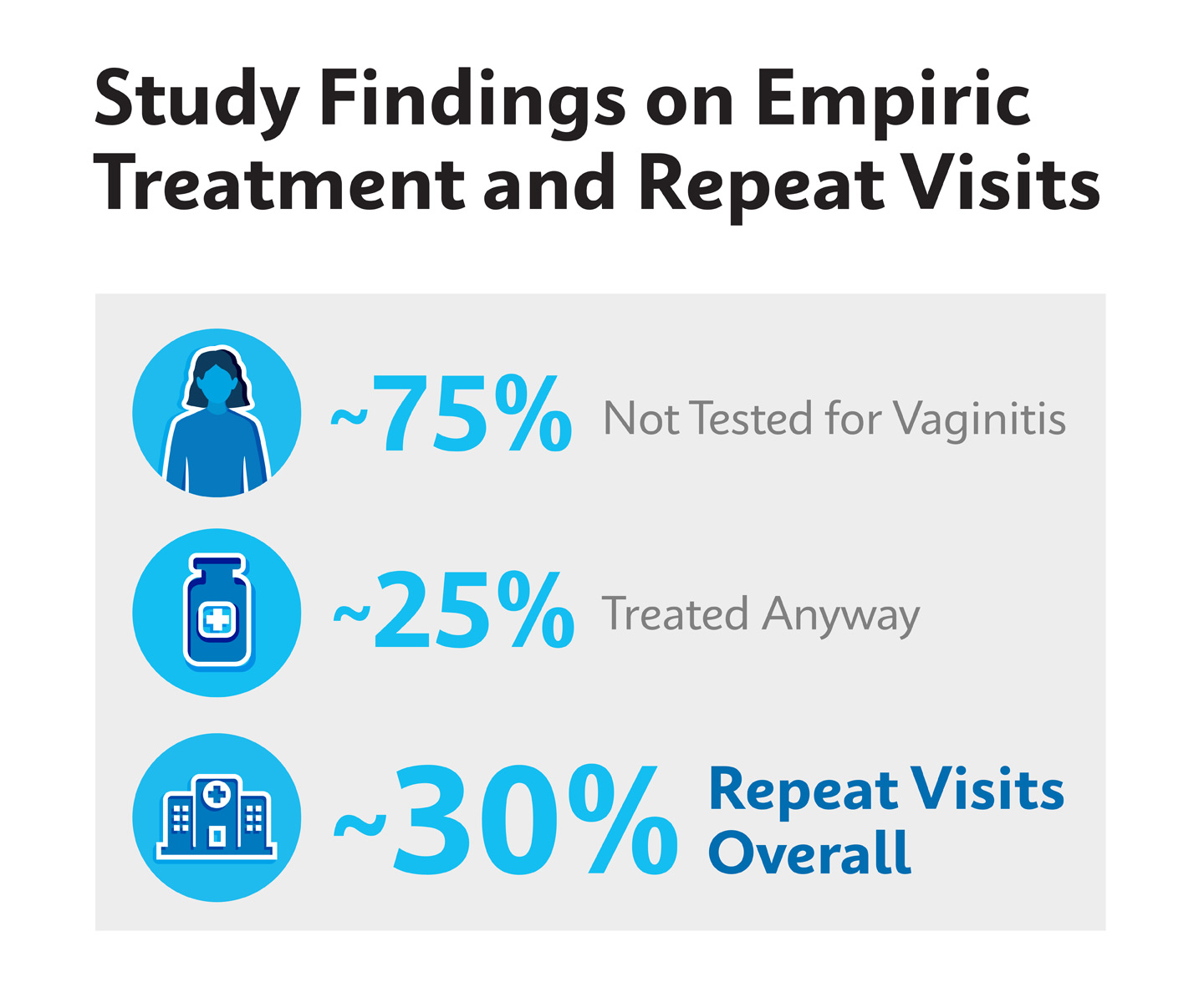Lecture de 5 m
18 août 2025
LA SANTÉ COMMUNAUTAIRE ET MONDIALE
Article
L’état du dépistage de la vaginite aux États-Unis : perspectives tirées des données du monde réel
Une récente étude publiée dans AJOG Global Reports1 offre un aperçu crucial de la façon dont la vaginite est actuellement prise en charge aux États-Unis, révélant que de nombreuses patientes symptomatiques ne sont pas testées pour la vaginite, mais reçoivent néanmoins un traitement lié à la vaginite.
Selon les auteurs de l’étude, « les résultats de cette étude suggèrent un besoin non satisfait pour un test diagnostique rapide et exact au plus proche des patientes afin d’améliorer l’efficacité diagnostique de la vaginite et d’augmenter la prescription éclairée, ce qui pourrait réduire le fardeau futur de la vaginite. »
L’étude souligne spécifiquement que les tests d’amplification de l’acide nucléique (TAAN) au plus proche des patientes du panel (VB, CVV, TV) sont de nouveaux outils diagnostiques que les fournisseurs de soins de santé doivent envisager s’ils cherchent à réduire les mauvais diagnostics et les mauvais traitements de la vaginite.
Qu’est-ce que la vaginite?
La vulvo-vaginite (ou simplement « vaginite ») est un spectre d’affections qui causent divers symptômes vaginaux ou vulvaires, y compris une inflammation, des démangeaisons, une sensation de brûlure, des douleurs, une odeur et des pertes vaginales. Les causes les plus courantes de vaginite sont :2.3
- Vaginose bactérienne (VB)
- Candidose vulvo-vaginale (CVV)
- Trichomonase (TV)
La vaginite est associée à des dommages graves, y compris des complications liées à la grossesse, une maladie inflammatoire pelvienne et un risque accru de contracter et de transmettre le VIH et d’autres IST.4
Examinons les résultats de l’étude1.
Un vaste ensemble de données en situation réelle révèle l’impact de la vaginite
Les chercheurs ont mené une analyse rétrospective tirant parti des données d’IQVIA concernant les demandes de remboursement relatives à des frais médicaux ambulatoires et des données longitudinales sur les demandes de remboursement relatives à des médicaments sur ordonnance pour les patientes présentant des symptômes de vaginite ou une vaginite entre 1 janvier 2018 et 30 septembre 2022. Au total, plus de 18,7 millions de personnes ont cherché à obtenir des soins pour leurs symptômes de vaginite ou leur vaginite pendant la période de l’étude, et un peu plus de 4 millions de ces personnes ont satisfait aux critères d’inclusion pour une analyse plus approfondie (213 261 patientes enceintes et 3 787 354 patientes non enceintes).
Les faibles taux de tests et les taux élevés de prescription empirique mènent à des soins sous-optimaux
L’analyse des données sur les réclamations a révélé qu’environ 75 % de la cohorte analytique n’avait pas de demande de remboursement pour un test de dépistage de la vaginite. De façon alarmante, malgré ce manque de tests, environ 25 % de ces patientes non testées ont tout de même reçu un traitement lié à la vaginite à la même date que leur visite initiale, ce qui suggère des taux élevés de prescription empirique.
La prescription empirique peut mener à une prise en charge sous-optimale, comme en témoigne le grand nombre de patientes qui ont eu des visites répétées à la clinique liées à la vaginite. L’étude a révélé qu’environ 30 % de la cohorte analysée avait eu au moins une visite répétée liée à la vaginite dans les 12 mois suivant leur visite initiale, ce qui engendrait un total de plus de 2 millions de visites supplémentaires à la clinique.

Parmi les patientes incluses dans l’analyse de l’étude qui ont passé des tests, les méthodes traditionnelles (voir l’encadré) étaient les plus courantes chez les patientes enceintes et non enceintes, suivies dans les deux cohortes par les TAAN avec seulement 1 à 2 cibles testées, et les tests avec sonde directe. Les panels TAAN, qui offrent la sensibilité et la spécificité les plus élevées, étaient la méthode la moins utilisée, utilisée chez seulement 8,3 % des patientes enceintes et 6,6 % des patientes non enceintes.
L’impact des différents types de tests peut être observé dans le fait que les patientes qui ont passé un panel TAAN lors de leur première visite étaient moins susceptibles d’avoir une visite répétée ou d’avoir besoin de traitements répétés que celles qui ont passé un test de dépistage utilisant une autre méthode. Bien que l’utilisation globale des panels TAAN ait été faible, ces résultats soulignent le potentiel que peuvent avoir des diagnostics plus exacts et multiplexés pour améliorer les résultats des patients et réduire le besoin de consultations médicales ultérieures.


p. ex., microscopie à l’état frais, culture, critères d’Amsel, coloration de Gram avec score de Nugent

- Sonde directe : détecte la présence d’ADN microbien spécifique sans amplification
- TAAN : amplifie le matériel génétique des microbes cibles. Le TAAN a une sensibilité et une spécificité plus élevées que les méthodes traditionnelles et les tests avec sonde directe.
Le TAAN au plus proche des patients est l’avenir
En raison des points forts du TAAN par rapport aux méthodes traditionnelles et aux tests avec sonde directe, la mise à jour de 2024 des lignes directrices de pratique de laboratoire conjointes de l’Infectious Disease Society of America (IDSA) et de l’American Society for Microbiology (ASM) recommande le TAAN en multiplex pour le diagnostic de la vaginite par rapport aux méthodes traditionnelles, principalement en raison d’une sensibilité plus élevée pour la VB, la CVV, la TV et les infections mixtes, et par rapport aux tests avec sonde directe en raison d’une spécificité plus élevée pour la VB.5
Un TAAN en laboratoire nécessite souvent un délai d’au moins un jour, ce qui pousse les cliniciens à prescrire des médicaments de façon empirique en attendant les résultats. Le mauvais diagnostic et le mauvais traitement peuvent avoir une incidence sur la santé reproductive et sexuelle, contribuer à la résistance antimicrobienne et nuire à la qualité de vie globale des femmes.
Pour résoudre ces problèmes, les auteurs préconisent l’adoption de tests TAAN exacts et rapides au plus proche des patientes, ce qui permettrait aux cliniciens d’aligner le traitement sur des résultats diagnostiques précis en temps réel, de réduire les visites répétées inutiles et de réduire le risque de maladie continue ou récurrente. Cela pourrait réduire le fardeau des soins de santé associé à la vaginite tout en améliorant les résultats pour les femmes à travers tout le pays.
Plaider en faveur des tests TAAN de dépistage de la vaginite au plus proche des patientes
Les fournisseurs de soins de santé et les administrateurs peuvent utiliser les points de discussion suivants pour préconiser l’apport des tests TAAN au plus proche des patientes dans leur établissement.
- Exactitude du diagnostic améliorée : la technologie PCR en multiplex permet la détection et la différenciation des causes les plus courantes de vaginite, y compris les co-infections, menant à un traitement plus ciblé et efficace.
- Visites de retour réduites : en fournissant des résultats exacts au plus proche des patientes, vous pouvez faciliter un traitement approprié dès la première fois, réduisant potentiellement les taux de visites répétées.
- Meilleure gestion des antibiotiques : Un traitement ciblé basé sur un diagnostic exact peut minimiser l’utilisation inappropriée de médicaments sur ordonnance et en vente libre et contribuer à la lutte contre la résistance antimicrobienne.
- Potentiel d’améliorer la qualité de vie des patientes : des tests diagnostiques rapides et exacts au plus proche des patientes peuvent réduire les erreurs de diagnostic et les mauvais traitements qui peuvent entraîner des résultats négatifs pour la santé, y compris la contraction et la transmission d’IST et des résultats indésirables à la naissance.
Références
1. Chen J et al. Real-world Clinical Burden of Patients Presenting with Vaginitis Symptoms in the United States, AJOG Global Reports, 2025, 100504, ISSN 2666-5778, https://doi.org/10:1016/j.xagr.2025:100504. https://www.sciencedirect.com/science/article/pii/S2666577825000656
2. Paladine HL, Desai UA. Vaginitis: Diagnosis and Treatment. Am Fam Physician. Mar 1 2018;97(5):321-329.
3. Workowski KA, Bachmann LH, Chan PA et al. Lignes directrices sur le traitement des infections sexuellement transmissibles, 2021. MMWR Recomm Rep. Jul 23 2021;70(4):1-187. doi:10:15585/mmwr.rr7004a1
4. Hildebrand JP, Carlson K, Kansagor AT. Vaginitis. [Mise à jour le 19 janvier 2025]. In: StatPearls [Internet]. Treasure Island (FL): StatPearls Publishing; 2025 Jan-. Disponible à partir de : https://www.ncbi.nlm.nih.gov/books/NBK470302/
5. Miller MJ et al. Guide to Utilization of the Microbiology Laboratory for Diagnosis of Infectious Diseases: 2024 Update by the Infectious Diseases Society of America (IDSA) and the American Society for Microbiology (ASM) , Clinical Infectious Diseases, 2024;, ciae104, https://doi.org/10:1093/cid/ciae104
Lire la suite
PLUS D’INFORMATIONS








